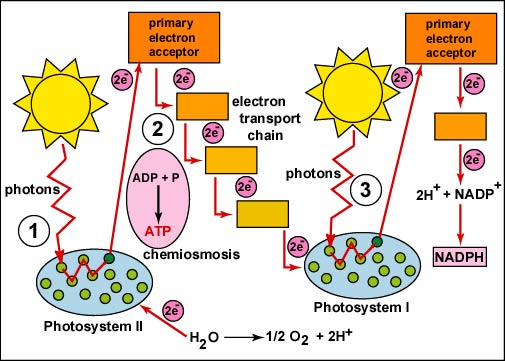Photosynthesis - Light Reactions
Cyclic and noncyclic photophosphorylation are two different pathways involved in the light-dependent reactions of photosynthesis, occurring in the thylakoid membranes of chloroplasts.
Noncyclic Electron Pathway
Overview: This pathway is the primary process in the light-dependent reactions and involves both Photosystem I (PSI) and Photosystem II (PSII).
1. This pathway occurs in the thylakoid membranes and requires participation of two light-gathering units: photosystem I (PS I) and photosystem II (PS II).
2. A photosystem is a photosynthetic unit comprised of a pigment complex and electron acceptor; solar energy is absorbed and high-energy electrons are generated.
3. Each photosystem has a pigment complex composed of green chlorophyll a and chlorophyll b molecules and orange and yellow accessory pigments (e.g., carotenoid pigments).
4. Absorbed energy is passed from one pigment molecule to another until concentrated in reaction-center chlorophyll a.
5. Electrons in reaction-center chlorophyll a become excited; they escape to electron-acceptor molecule.
6. The noncyclic pathway begins with PSII; electrons move from H2O through PS II to PS I and then on to NADP+.
7. The PS II pigment complex absorbs solar energy; high-energy electrons (e-) leave the reaction-center chlorophyll a molecule.
8. PS II takes replacement electrons from H2O, which splits, releasing O2 and H+ ions:
9. Oxygen is released as oxygen gas (O2).
10. The H+ ions temporarily stay within the thylakoid space and contribute to a H+ ion gradient.
11. As H+ flow down electrochemical gradient through ATP synthase complexes, chemiosmosis occurs.
12. Low-energy electrons leaving the electron transport system enter PS I.
13. When the PS I pigment complex absorbs solar energy, high-energy electrons leave reaction-center chlorophyll a and are captured by an electron acceptor.
14. The electron acceptor passes them on to NADP+.
15. NADP+ takes on an H+ to become NADPH: NADP+ + 2 e- + H+ NADPH.
16. NADPH and ATP produced by noncyclic flow electrons in thylakoid membrane
are used by enzymes in stroma during light-independent reactions.
Outcome: The key products of noncyclic photophosphorylation are ATP and NADPH, which are essential for the Calvin Cycle (light-independent reactions) to convert carbon dioxide into sugars.
Cyclic Electron Pathway
Overview: This pathway utilizes only Photosystem I (PSI) and does not involve Photosystem II (PSII). It's a simpler pathway that can occur under specific conditions, such as when there's a shortage of NADP⁺ or when the light intensity is high.

1. The cyclic electron pathway begins when the PS I antenna complex absorbs
solar energy.
2. High-energy electrons leave PS I reaction-center chlorophyll a molecule.
3. Before they return, the electrons enter and travel down an electron transport
system.
a. Electrons pass from a higher to a lower energy level.
b. Energy released is stored in form of a hydrogen (H+) gradient.
c. When hydrogen ions flow down their electrochemical gradient through ATP synthase complexes, ATP production occurs.
d. Because the electrons return to PSI rather than move on to NADP+, this is why it is called cyclic and also why no NADPH is produced.
Outcome: Cyclic photophosphorylation produces ATP but does not result in the production of NADPH or the release of oxygen.
Comparing the Two Pathways
-
Noncyclic Photophosphorylation: Produces both ATP and NADPH, requires both Photosystem I and Photosystem II, and contributes to the generation of oxygen.
-
Cyclic Photophosphorylation: Produces only ATP, involves Photosystem I alone, and does not result in the production of NADPH or oxygen release.
